UPSC Daily Current Affairs: 6th October 2024 | Current Affairs & Hindu Analysis: Daily, Weekly & Monthly PDF Download
GS1/History & Culture
Who was Rani Durgavati?
Source: The Hindu
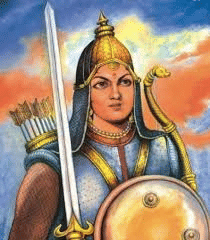
Why in News?
The Madhya Pradesh cabinet recently approved the formation of a panel to develop a memorial and garden dedicated to Gond queen Rani Durgavati for Rs 100 crore.
- Rani Durgavati (1524-1564) was a prominent figure from the Chandela dynasty, ruling over the Gond kingdom of Garha-Katanga.
- She was born on October 5, 1524, into the family of the renowned Chandel emperor, Keerat Rai.
- The Chandel dynasty is noted in Indian history for its courageous king, Vidyadhar, who successfully defended against the invasions of Mehmood Gaznavi.
- Rani Durgavati was born in Kalinjar, a significant fort in Banda, Uttar Pradesh, known for its historical importance.
- In 1542, she married Dalpatshah, the eldest son of King Sangramshah of the Gond Dynasty, strengthening ties between the Chandel and Gond dynasties.
- She gave birth to her son, Vir Narayan, in 1545; however, Dalpatshah passed away around 1550, leaving Rani Durgavati to govern as her son was still an infant.
- Two ministers, Adhar Kayastha and Man Thakur, aided her in managing the kingdom efficiently.
- Rani Durgavati moved the capital from Singaurgarh to Chauragarh, a strategically important fort located in the Satpura range.
- During her reign, trade thrived, and the populace enjoyed prosperity.
- Continuing the legacy of her husband's ancestors, she expanded her territory and achieved political unification in Gondwana, also known as Garha-Katanga, through her bravery and diplomacy.
- She proved her mettle as a warrior by successfully combating Baz Bahadur, the Sultan of Malwa.
- In 1562, the Mughal Empire under Akbar subdued Malwa, which brought Rani Durgavati’s territory into proximity with the Mughal Empire.
- She is most celebrated for her valiant defense of Gondwana against the Mughal forces, demonstrating remarkable courage and leadership.
- Although she eventually faced defeat against the Mughal army, her legacy as a fierce warrior endures.
GS3/Economy
India’s energy demand to triple by 2050
Source: The Hindu
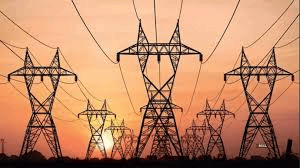
Why in news?
India is being recognized as a significant contributor to the global energy transition, propelled by a robust 7% GDP growth and escalating power requirements. Experts have pointed out that India has become the third-largest power market, with energy demand projected to triple by 2050. Despite advancements in renewable energy, coal still accounts for 70% of India's energy production, with expectations of 50 GW of coal and 10 GW of nuclear energy by 2030. The emphasis is on enhancing electrification, energy storage solutions, and grid infrastructure. Moreover, the anticipated increase in solar and wind projects is expected to surpass coal plant installations by 2030. The critical role of battery energy storage systems (BESS) in managing renewable energy fluctuations and ensuring grid stability is also highlighted.
India’s energy profile
- India is experiencing rapid growth in energy demand, yet its per capita energy usage remains low compared to global standards.
- As of 2023, India ranks third globally in primary energy consumption at 39.02 exajoules (EJ), following China (170.74 EJ) and the USA (94.28 EJ).
- Per capita energy consumption in India is only 27.3 gigajoules (GJ), significantly lower than China’s 120 GJ and the US’s 277.3 GJ.
- India's per capita consumption is similar to that of several Southern African nations (excluding South Africa) and much below the world average of 77 GJ.
- While energy use is on the rise, India is still far from the consumption levels typical of high human development, which is approximately 100 GJ per person.
Energy consumption
Growth
- In 2023, energy consumption in India grew by over 7.3%, compared to a growth of 5.6% in 2022.
- The post-pandemic revival of economic activities significantly contributed to the rise in energy consumption.
Fossil Fuel Consumption
- India’s Coal Consumption in 2023:
- Coal consumption for electricity generation reached 749 million tonnes (MT), surpassing the combined total of the US (280 MT) and Europe (286 MT).
- This increase is attributed to a decline in coal consumption in the US and Europe, which are transitioning to cleaner energy sources.
- US coal use fell over 17%, and Europe saw a decrease of more than 16%, while India's coal consumption rose by 9% due to industrial activities and increased household electricity demands during a hot summer.
- Despite this, per capita coal consumption in the US remains over 50% higher than in India, and China's per capita consumption is four times greater than India's.
- India’s Oil Consumption in 2023:
- Oil consumption stood at 5.18 million barrels per day, making India the fourth-largest consumer globally, after the US, China, and Europe.
- The US's oil consumption is nearly equivalent to the combined totals of China and India.
- Per capita oil use in the US is more than 15 times that of India.
- India’s Natural Gas Consumption in 2023:
- Natural gas consumption was 62.6 billion cubic meters (BCM), representing only 1.6% of global consumption.
- The US leads in gas consumption at 886.5 BCM, followed by Europe (463.4 BCM) and Russia (453.4 BCM).
Non-Fossil Fuel Consumption
- Hydropower consumption in India fell by 15% in 2023 due to lower rainfall, following an 8.9% growth in 2022.
- Despite this decline, India ranks fourth in global renewable energy consumption, trailing behind China, the US, and Europe, which collectively account for nearly 60% of global renewables usage.
- India contributed 6.9% of global renewable energy consumption, reflecting an impressive annual growth rate of 18.7% in 2023.
India's Energy Profile vs. Global Energy Profile
- India's energy consumption profile shows significant differences compared to global averages in terms of coal and natural gas usage.
- Coal constitutes 59% of India’s commercial energy consumption, while globally it accounts for only 26%.
- Natural gas comprises around 6% of India’s energy mix, against a global average of 26%.
- This disparity is primarily due to India's domestic coal availability, which ensures energy security and affordability.
- For other energy sources, India aligns more closely with global averages.
Overemphasis on Coal in the Global South
- The prevalent global narrative tends to exaggerate coal consumption in the Global South while downplaying oil and natural gas consumption in the Global North, despite all being carbon-emitting fossil fuels.
- This perspective overshadows the underconsumption of energy in the Global South, which leads to more serious health and economic repercussions.
Energy Consumption: Global South vs. Global North
- The Global South, which comprises 85% of the global population and 39% of global GDP, consumed over 389 exajoules (EJ) of energy, contrasting with the Global North’s 286 EJ.
- Given these disparities, it is essential for the Global South, led by India, to reshape the global energy narrative to accurately reflect its challenges and realities.
GS3/Environment
What are Hammerhead Sharks?
Source: Indian Express

Why in News?
Scientists have recently identified a new species of hammerhead shark known as Sphyrna alleni, found in the Caribbean and the Southwest Atlantic.
About Hammerhead Sharks:
- Hammerhead sharks are named for their unique and distinctive head shape.
- They belong to the family Sphyrnidae and are characterized by their flattened, hammer-like head, referred to as a 'cephalofoil'.
- This unique head shape provides several advantages, such as:
- 360-degree vision, allowing them to see their surroundings effectively.
- Enhanced hunting capabilities due to improved sensory perception.
- There are nine recognized species of hammerhead sharks, each varying in size.
- The great hammerhead is the largest species, capable of reaching lengths of up to 20 feet.
Distribution
- Hammerhead sharks are commonly found in tropical and temperate marine environments, particularly near coastlines and on continental shelves.
- They exhibit seasonal migration patterns, moving towards the equator during winter and heading poleward in the summer.
- During warm El Niño events, these sharks may travel hundreds of kilometers beyond their usual range.
Features
- The upper body of hammerhead sharks is typically greyish-brown or olive-green, while their bellies are white.
- They possess sharp, triangular, serrated teeth, resembling a saw's edge, which are effective for catching prey.
- Hammerheads have specialized sensory organs located across their heads, enabling them to detect food in the ocean effectively.
- They are viviparous, meaning they carry fertilized eggs inside their bodies and give birth to live young.
- These sharks can live for 20 to 30 years.
- As exothermic animals, they do not have a mechanism for regulating their internal body temperature.
- Hammerhead sharks are among the most endangered shark families, primarily due to overfishing. All species except one (Sphyrna gilberti) are classified as Vulnerable, Endangered, or Critically Endangered by the IUCN.
GS1/Geography
Lipulekh Pass
Source: The Hindu
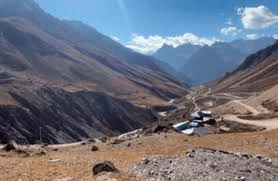 Why in News?
Why in News?
Recently, pilgrims had their first-ever view of the sacred Kailash peak from the Old Lipulekh Pass located in Indian territory.
About
- Location: Lipulekh Pass is a high-altitude mountain pass situated in the Kumaon region of Uttarakhand, close to the trijunction of India, Nepal, and China.
- Geographical Connection: This pass serves as a vital link between the Indian state of Uttarakhand and the Tibet region of China.
- Altitude: The pass is positioned at an elevation of approximately 5,334 meters (17,500 feet), making it one of the higher passes in the Himalayas.
- Strategic Importance: Its elevation and strategic location render it a gateway to the upper Himalayan regions.
- Religious Significance: The Old Lipulekh Pass is located in the Vyas Valley of the Pithoragarh district in Uttarakhand and holds significant religious importance.
- Trade History: It was the first Indian border post opened for trade with China in 1992, followed by Shipki La Pass in Himachal Pradesh in 1994 and Nathu La Pass in Sikkim in 2006.
Significance
- Ancient Trade Route: For centuries, Lipulekh Pass has been a crucial trade route connecting the Indian subcontinent with the Tibetan plateau.
- Religious Importance: The pass is a key component of the Kailash Mansarovar Yatra, a sacred pilgrimage for Hindus. Devotees undertake this challenging journey to reach Mount Kailash, which is revered as the abode of Lord Shiva, along with the nearby Mansarovar Lake.
GS3/Environment
Indian Grey Wolf
Source: DTE
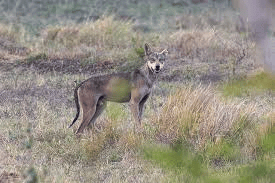
Why in news?
The Indian grey wolf is gaining attention due to its crucial role in maintaining ecological balance in its habitat by preying on weaker and sick animals, thereby acting as nature's culling agent in the rugged terrains of central Karnataka.
About Indian Grey Wolf:
- The Indian grey wolf is a subspecies of the grey wolf found in regions from Southwest Asia to the Indian Subcontinent.
- This wolf typically travels in smaller packs compared to other wolf species and is known for being less vocal.
- They are primarily nocturnal hunters, active from dusk until dawn.
Appearance:
- The Indian grey wolf is of medium size, positioned between the Tibetan and Arabian wolves.
- Due to its adaptation to warmer climates, it lacks the dense winter coat found in the Tibetan wolf.
Habitat:
- These wolves are found in regions characterized by scrublands, grasslands, and semi-arid pastoral areas.
Distribution:
- The Indian grey wolf has a broad distribution across the Indian subcontinent and extends to Israel.
- Current estimates suggest a population of around 3,000 individuals in India, with some residing in captivity.
Conservation Status:
- IUCN: Listed as Least Concern, indicating that the species is not currently at risk of extinction.
- CITES: Included in Appendix 1, signifying that it faces a high risk of extinction in the wild.
- Wildlife (Protection) Act of 1972: Classified under Schedule I, offering it the highest level of protection.
- Threats:
- The primary threats to the Indian grey wolf include habitat loss and a decrease in the availability of prey species.
GS3/Environment
Why is Salt Pan Land Being Used for Homes?
Source: The Hindu
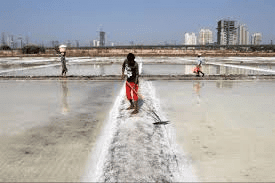
Why in News?
The Maharashtra government has made a significant decision to utilize 255.9 acres of salt pan land in Mumbai's eastern suburbs for the Dharavi Redevelopment Project. This initiative aims to construct rental housing for residents displaced from the slum area of Dharavi. The decision has ignited discussions among urban planners, environmentalists, and officials regarding its ecological and urban planning implications.
Background (Context of the Article)
- In October 2024, the Maharashtra government announced the allocation of land for housing developments as part of the Dharavi Redevelopment Project.
- The project aims to provide homes for residents living in the overcrowded Dharavi slum.
- This move has raised questions about the environmental impact and urban planning in densely populated areas.
About Salt Pans (Meaning, Maharashtra’s Plan, Terms, Concerns, Way Ahead, etc.)
- Salt pans are coastal low-lying areas where seawater is evaporated to produce salt.
- These areas are ecologically important as they:
- Act as natural sponges, absorbing rainwater and reducing flood risks.
- Support diverse flora and fauna, providing vital habitats.
- Contribute to coastal defense systems against storms and flooding.
- In Maharashtra, there are approximately 13,000 acres of salt pan land available for potential development.
- The government plans to utilize three major parcels of salt pan land for the Dharavi project:
- Arthur Salt Works Land in Kanjur (120.5 acres)
- Jenkins Salt Works Land in Kanjur and Bhandup (76.9 acres)
- Jamasp Salt Works Land in Mulund (58.5 acres)
- The Dharavi Redevelopment Project aims to repurpose these lands for affordable housing as part of the Development Control and Promotion Regulations (DCPR) 2034.
- The land is owned by the Central government, which approved the transfer of these parcels to the Maharashtra government in September 2024.
Terms for the Allocation of Land
- The Maharashtra government has established specific conditions for the lease of salt pan land:
- The land will be leased for a duration of 99 years.
- The cost will be set at 25% of the current market rate.
- The Dharavi Redevelopment Project Private Limited (DRPPL), a Special Purpose Vehicle (SPV) with an 80% stake held by the Adani Group and 20% by the state, will handle land revenue payments.
- The SPV is also responsible for the costs associated with resettling workers from the salt pans.
- The allocated land is strictly designated for slum rehabilitation and affordable housing, prohibiting any commercial use.
Concerns from Urban Planners & Environmentalists
- The decision to allocate ecologically sensitive salt pan land for housing has prompted several concerns:
- Ecological Impact: Salt pans are crucial for protecting against flooding, especially those near the Eastern Express Highway. Urban planners advocate for conducting an impact assessment study prior to large-scale construction.
- Formation of Ghettos: The relocation of residents could lead to community segregation rather than integration. Planners suggest in-situ rehabilitation, keeping people close to their original neighborhoods.
- Legal Challenges: Environmentalists warn that intensive urban activities could disrupt this delicate ecosystem, potentially leading to legal disputes over environmental clearances. Approval from the Ministry of Environment, Forest and Climate Change (MoEFCC) will be necessary before construction begins.
Conclusion
- The use of salt pan lands for housing, particularly in the Dharavi Redevelopment Project, presents a complex challenge of balancing urban development needs with environmental protection. While the Maharashtra government aims to address housing shortages for economically weaker sections, there is a pressing need for thorough ecological assessments to mitigate long-term repercussions. Given the role of salt pans in flood defense, careful consideration and impact studies are essential before proceeding with such developments.
GS3/Defence & Security
What is Very Short-Range Air Defence System (VSHORADS)?
Source: AIR
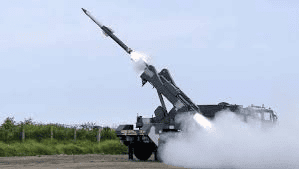
Why in News?
India has successfully conducted tests for its fourth-generation very short-range air defence system.
About Very Short-Range Air Defence System (VSHORADS):
- VSHORADS is a type of Man Portable Air Defence System (MANPAD) designed to counter low-altitude aerial threats over short distances.
- This system has been developed and designed in India by the Defence Research and Development Organisation (DRDO) at the Research Centre Imarat, Hyderabad, in collaboration with various DRDO laboratories and industry partners.
- The missile design, including the launcher, has been optimized for high portability, allowing for easy deployment and operation without requiring a large team.
- Innovative technologies have been integrated into the VSHORADS missile, including a miniaturized Reaction Control System (RCS) and advanced avionics.
- The propulsion system of the missile utilizes a dual-thrust solid motor, enhancing its performance and reliability.
- The operational range of the VSHORADS missile extends up to 6 kilometers, making it effective against potential aerial threats.
- This man-portable missile system is specifically designed to be lightweight compared to other missile systems, which facilitates rapid deployment in challenging terrains, such as mountainous areas near the Line of Actual Control (LAC) with China in regions like Ladakh and Arunachal Pradesh.
GS2/Polity
 |
Download the notes
UPSC Daily Current Affairs: 6th October 2024
|
Download as PDF |
National Urban Livelihood Mission (NULM 2.0)
Source: Times of India
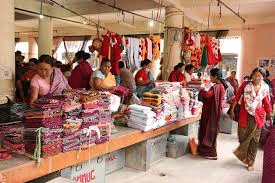
Why in News?
The Government will soon launch the next iteration of the livelihood mission aimed at supporting the urban poor and vulnerable groups, known as National Urban Livelihood Mission (NULM 2.0).
This new version will target six specific groups, which include:
- Construction workers
- Gig workers
- Waste management workers
- Care workers
- Domestic workers
- Transportation workers
The NULM was initiated by the Union Ministry of Housing and Urban Poverty Alleviation (MHUPA) in 2013, replacing the previous Swarna Jayanti Shahari Rozgar Yojana (SJSRY). It was renamed to DAY-NULM in 2016.
The mission’s key focus areas are:
- Organizing urban poor into strong grassroots institutions, such as self-help groups (SHGs), to enhance their livelihoods sustainably.
- Creating skill development opportunities that lead to market-driven employment.
- Assisting individuals in establishing self-employment ventures through easy access to credit.
The mission aims to:
- Provide shelters with essential services to the urban homeless in a phased approach.
- Address the livelihood issues of urban street vendors by facilitating access to:
- Suitable spaces
- Institutional credit
- Social security and skills to access new market opportunities
Implementation and Performance of the DAY-NULM:
Implementation:
- The primary focus of NULM is the urban poor, including the urban homeless.
- NULM has been implemented in all district headquarters and towns with a population of over 100,000 as per the 2011 Census.
- Currently, 790 cities are included under NULM. Other towns may be incorporated under specific circumstances upon state requests.
Funding:
- The funding for NULM is shared between the Central and State governments at a ratio of 75:25.
- For North Eastern and Special Category States, this ratio is 90:10.
Performance:
- More than 89.33 lakh women have formed 8.74 lakh SHGs under the mission.
- Out of these, 6.12 lakh SHGs have received a revolving fund of Rs 10,000 each to initiate their activities.
- Approximately 15 lakh beneficiaries have received skill training, with 8.20 lakh successfully placed in employment.
- Additionally, 8.83 lakh beneficiaries have been supported in starting their own businesses or group ventures.
- For street vendors, the mission has conducted surveys in 3,467 cities to assess their numbers.
- A total of 53.76 lakh vendors were identified, resulting in 37.52 lakh vendors receiving certificates of vending and 30.99 lakh being issued ID cards.
Under the initiative, the government will enable eligible urban poor individuals or groups to access microcredit of up to Rs 4 lakh and Rs 20 lakh, respectively.
This microcredit will be available at a subsidized interest rate of 5% and will help beneficiaries to:
- Initiate enterprises
- Establish social infrastructure, such as labor chowks
- Obtain innovation grants for purposes like acquiring sanitation machinery
To lay the groundwork for NULM 2.0, the Centre will conduct a pilot project across 25 cities to identify urban poor for effectively targeting government schemes aimed at enhancing their income and living conditions.
GS2/Governance
Co-district Initiative
Source: New Indian Express

Why in news?
Recently, the Assam government introduced an innovative approach called the "co-district" initiative, which modifies the traditional structure of civil sub-divisions within district administration. This initiative aims to enhance governance by creating smaller administrative units within districts.
About the Co-district Initiative:
- Co-districts are defined as smaller administrative units that exist beneath the district level.
- These units will be overseen by an officer with the rank of Assistant District Commissioner.
- This initiative is the first of its kind in India, aiming to bring governance closer to the citizens.
- It seeks to tackle various administrative challenges that district administrations currently face.
Powers of Co-district Commissioners:
- Co-district commissioners will possess powers and responsibilities akin to those of district commissioners.
- Their duties will encompass land revenue management, development efforts, welfare initiatives, excise duties, and disaster management tasks.
Administrative Control:
- Co-district commissioners will have authority over all departments operating within their respective co-districts.
- They will also hold magisterial powers, which include issuing permissions for various events.
Routine Administrative Functions:
- These officers will handle essential administrative tasks such as issuing ration cards and caste certificates.
- They will also manage the sale permissions for land, ensuring that these processes are efficient and accessible to the public.
GS3/Economy
What is Business- Ready Index?
Source: Money Control

Why in News?
The Indian government is working towards aligning state business readiness rankings with the forthcoming World Bank’s B-READY index.
About
- The Business-Ready Index (B-READY) is a new initiative that follows the Ease of Doing Business rankings, which were stopped in 2021 due to various irregularities.
- This innovative index aims to quantitatively evaluate the business environment across different economies around the world.
- It intends to consider a wider range of factors when determining the ratings for business environments.
- Global financial institutions and multinational corporations will refer to the B-READY framework as a standard to gauge the regulatory and policy landscape of various countries.
- The index will be published annually and will focus on three primary pillars: regulatory framework, public services, and efficiency.
- It integrates aspects such as digitalization, environmental sustainability, and gender equality into every indicator, promoting a comprehensive and progressive approach to evaluating business conditions.
- The B-READY index tracks ten key parameters that encompass the entire lifecycle of a firm, including starting, operating, closing, and reorganizing a business.
- The index will be expanded in three phases, initially covering 54 economies and potentially reaching up to 180 countries by 2026.
GS2/International Relations
Israel’s ban on the UN chief
Source: The Hindu

Why in news?
Recently, Israel imposed a ban on United Nations Secretary-General (UNSG) António Guterres, preventing him from entering the country. This action was taken due to allegations that he supports groups such as Hamas, Hezbollah, the Houthis, and Iran.
Reason for Declaration
- The Israeli Foreign Minister labeled UNSG António Guterres as persona non grata (PNG), effectively barring him from Israel.
- This decision stemmed from the UNSG's perceived failure to "unequivocally condemn" missile strikes from Iran targeting Israel.
- Israel criticized Guterres for his lack of condemnation regarding a Hamas attack on October 7, 2023, which caused approximately 1,200 Israeli casualties and resulted in 250 hostages being taken.
UNSG's Previous Statements
- Despite Israel's accusations, Guterres and other UN entities have repeatedly condemned Hamas's actions.
- In April, the UNSG denounced the use of "sexual violence, torture, and kidnapping of civilians," describing Hamas's actions as unjustifiable.
Guterres’ Response to Recent Escalations
- During the recent escalation of conflict, including Israeli military actions in Lebanon and Iran's missile attacks on Israeli bases, Guterres called for a ceasefire and condemned the escalation of hostilities without specifically naming either side.
- After the declaration of PNG status, Guterres clarified his stance by strongly condemning the "massive missile attack by Iran on Israel," yet the ban from Israel remained in effect.
Unprecedented Nature of Israel's Ban of UNSG
- This ban marks a unique occurrence in the history of Israel-UN relations.
- Historically, the closest parallel occurred in 1950 when the USSR accused UNSG Trygve Lie of bias during the Korean crisis, threatening to veto his re-election.
- In 1987, former UNSG Kurt Waldheim faced a ban from the U.S. due to his involvement in Nazi war crimes, but this was after his tenure as UNSG.
- Article 100, paragraph 2 of the UN Charter emphasizes the necessity for member states to respect the independence of the Secretary-General for both functional and logistical purposes.
Israeli Criticism of the UN
- This ban on Guterres is part of Israel's broader narrative that the UN is dominated by an "anti-Israel" coalition of Arab and Islamic nations.
- Israel accuses affiliated organizations, such as the United Nations Relief and Works Agency (UNRWA), of collusion with Hamas.
Israeli Prime Minister's Accusations
- During a UN General Assembly session, Israeli Prime Minister Benjamin Netanyahu labeled the UN as an "anti-Semitic swamp," expressing frustration over resolutions that called for a ceasefire and criticized Israel, which garnered widespread support from other nations.
Previous Bans on UN Officials
- Israel has a history of banning UN officials and rapporteurs, claiming bias against Israel and favoritism towards the Palestinian cause.
- Last year, Israel prohibited UN Under-Secretary General Martin Griffiths from entering the country due to his remarks viewed as critical of Israel's occupation of Palestinian territories.
Global Reactions to Israel's Ban on UNSG
- The day following Israel's ban, the UN Security Council, with consensus from all P-5 members, issued a statement deeming the decision "counterproductive," particularly in light of rising tensions in the Middle East.
- The U.S. State Department also criticized the ban, stating it was "not productive" for Israel's international standing.
- India's Ministry of External Affairs, while cautious, affirmed that Guterres continues to be recognized as the UNSG by India.
|
39 videos|4566 docs|979 tests
|
FAQs on UPSC Daily Current Affairs: 6th October 2024 - Current Affairs & Hindu Analysis: Daily, Weekly & Monthly
| 1. Who was Rani Durgavati and what were her contributions to Indian history? |  |
| 2. What is the significance of India's energy demand tripling by 2050? |  |
| 3. What are Hammerhead Sharks and why are they important to marine ecosystems? |  |
| 4. Why is Salt Pan Land Being Used for Homes in India? |  |
| 5. What is the Very Short-Range Air Defence System (VSHORADS) and its significance for India? |  |

































